Iowa-class battleship
 USS Iowa (BB-61) fires a full broadside on 15 August 1984 during a firepower demonstration after her recommissioning. | |
| Class overview | |
|---|---|
| Name: | Iowa-class battleship |
| Builders: |
|
| Operators: |
|
| Preceded by: | South Dakota class |
| Succeeded by: | Montana class (planned) |
| Cost: | US$100 million per ship |
| Built: | 1940–1944 |
| In commission: |
|
| Planned: | 6 |
| Completed: | 4 |
| Cancelled: | 2 |
| Retired: | 4 |
| Preserved: | 4 |
| General characteristics | |
| Type: | Battleship |
| Displacement: |
|
| Length: | |
| Beam: | 108 ft (33 m) |
| Draft: | 36 ft (11 m) maximum |
| Installed power: |
|
| Propulsion: |
|
| Speed: | 32.5 knots (60.2 km/h; 37.4 mph) (up to 35.2 knots (65.2 km/h; 40.5 mph) on light load.) |
| Range: | 14,890 miles (23,960 km) @15 knots (28 km/h; 17 mph) |
| Complement: |
|
| Electronic warfare & decoys: | |
| Armament: |
|
| Armor: | |
| Aircraft carried: |
|
| Notes: | Final battleship class completed by the United States |
The Iowa-class battleships were a class of fast battleships ordered by the United States Navy in 1939 and 1940 to escort the Fast Carrier Task Forces that would operate in the Pacific Theater of World War II. Four were completed; two more were laid down but canceled at war's end and scrapped. Like other third-generation American battleships, the Iowa class followed the design pattern set forth in the preceding North Carolina-class and South Dakota-class battleships, which emphasized speed in addition to secondary and anti-aircraft batteries.[1]
Between the mid-1940s and the early 1990s, the Iowa-class battleships fought in four major U.S. wars. In World War II, they defended aircraft carriers and shelled Japanese positions. During the Korean War, the battleships provided seaborne artillery support for United Nations forces fighting North Korea, and in 1968, New Jersey shelled Viet Cong and Vietnam People's Army forces in the Vietnam War. All four were reactivated and armed with missiles during the 1980s as part of the 600-ship Navy initiative; during Operation Desert Storm in 1991, Missouri and Wisconsin fired missiles and 16-inch (406 mm) guns at Iraqi targets.
Costly to maintain, the battleships were decommissioned during the post-Cold War draw down in the early 1990s. All four were initially removed from the Naval Vessel Register; however, the United States Congress compelled the Navy to reinstate two of them on the grounds that existing naval gunfire support would be inadequate for amphibious operations. This resulted in a lengthy debate over whether battleships should have a role in the modern navy. Ultimately, all four ships were stricken from the Naval Vessel Register and released for donation to non-profit organizations. With the transfer of Iowa in 2012, all four are part of various non-profit maritime museums across the U.S.
Background
Work on what would eventually become the Iowa-class battleships began on the first study in early 1938 at the direction of Admiral Thomas C. Hart, head of the General Board. It was an expanded South Dakota, carrying either twelve 16-inch/45 caliber Mark 6 guns or nine 18-inch (460 mm) guns—the latter armament being dropped after the 31 March agreement—with more armor and a power plant large enough to drive the larger ship through the water at the same speed as the South Dakotas, 27 knots (50 km/h; 31 mph).[2] These studies had no further impact on the design of the Iowa class, but development of this design continued and eventually evolved into the design for the Montana class.[3]
Another design, pursued by the Design Division section of the Bureau of Construction and Repair, was a "cruiser-killer". Beginning on 17 January 1938 under Captain A. J. Chantry, the group drew up plans for ships with twelve 16-inch and twenty 5-inch guns, Panamax capability but otherwise unlimited displacement, a top speed of 35 knots (65 km/h; 40 mph) and a range of 20,000 nautical miles (37,000 km; 23,000 mi) when traveling at the more economical speed of 15 knots (28 km/h; 17 mph). Their plan fulfilled these requirements with a ship of 50,940 long tons (51,760 t), but Chantry believed that more could be done if the ship were to be this large; with a displacement greater than that of most battleships, its armor would only have protected it against the 8-inch (203 mm) weapons carried by heavy cruisers.[4]
Three improved plans—"A", "B", and "C"—were designed at the end of January. An increase in draft, vast additions to the armor,[N 1] and the substitution of twelve 6-inch (150 mm) guns in the secondary battery was common between the three designs. "A" was the largest, at 59,060 long tons (60,010 t), and was the only one to still carry the twelve 16-inch guns in four triple turrets (3-gun turrets according to U.S. Navy). It required 277,000 shaft horsepower (shp) to make 32.5 knots (60.2 km/h; 37.4 mph). "B" was the smallest at 52,707 long tons (53,553 t); like "A" it had a top speed of 32.5 knots, but "B" only required 225,000 shp to make this speed. It also carried only nine 16-inch guns, in three triple turrets. "C" was similar but it added 75,000 shp (for a total of 300,000 shp), to make the original requirement of 35 knots. The weight required for this and a longer belt—512 feet (156 m), compared with 496 feet (151 m) for "B"—meant that the ship was 55,771 long tons (56,666 t).[5]
In March 1938, the General Board followed the recommendations of the Battleship Design Advisory Board, which was composed of the naval architect William Francis Gibbs, William Hovgaard (then president of New York Shipbuilding), John Metten, Joseph W. Powell, and the long-retired Admiral and former Chief of the Bureau of Ordnance Joseph Strauss. The board requested an entirely new design study, focusing on increasing the size of the 35,000 ton South Dakota class. The first plans made for this indicated that 30 knots (35 mph; 56 km/h) was possible on a displacement of about 37,600 long tons (38,200 t). 33 knots (38 mph; 61 km/h) could be bought with 220,000 shaft horsepower and a displacement of around 39,230 long tons (39,860 t), which was well below the Second London Naval Treaty's maximum limit of 45,000 long tons (46,000 t).[6]
These designs were able to convince the General Board that a reasonably well-designed and balanced 33-knot (61 km/h) battleship was possible within the terms of the "escalator clause". However, further studies revealed major problems with the estimates. The speed of the ships meant that more freeboard would be needed both fore and amidships, the latter requiring an additional foot of armored freeboard. Along with this came the associated weight in supporting these new strains: the structure of the ship had to be reinforced and the power plant enlarged to avoid a drop in speed. In all, about 2,400 long tons (2,400 t) had to be added, and the large margin the navy designers had previously thought they had—roughly 5,000 long tons (5,100 t)—was suddenly vanishing.[7]
With the additional displacement, the General Board was incredulous that a tonnage increase of 10,000 long tons (10,000 t) would only allow the addition of 6 knots (11 km/h; 6.9 mph)s over the South Dakotas. Rather than retaining the 16"/45 caliber Mark 6 gun used in the South Dakotas, they ordered that future studies would have to include the more powerful (but heavier) 16"/50 caliber Mark 2 guns left over from the canceled Lexington-class battlecruisers and South Dakota-class battleships of the early 1920s. It also allowed the draft of the ships to be increased, meaning that the ships could be shortened (lowering weight) and the power reduced (since a narrower beam reduces drag).[8]
The 50-caliber gun weighed some 400 long tons (410 t) more than the 45 caliber did; the barbette size also had to be increased so the total weight gain was about 2,000 long tons (2,000 t), putting the ship at a total of 46,551 long tons (47,298 t)—well over the 45,000 long ton limit. An apparent savior appeared in a Bureau of Ordnance preliminary design for a turret that could carry the 50 caliber guns in a smaller barbette. This breakthrough was shown to the General Board as part of a series of designs on 2 June 1938.[9]
However, the Bureau of Ordnance continued working on a larger barbette design, while the Bureau of Construction and Repair utilized the smaller barbettes in the final planning of the new battleships. As the bureaus were independent of one another, they did not realize that the two plans could not go together until November 1938, when the design was in the final stages of refinement. By this time, the ships could not use the larger barbette, as it would require massive alterations to the design and would result in substantial weight penalties. The General Board was astounded; one member asked the head of the Bureau of Ordnance if it had occurred to him that Construction and Repair would have wanted to know what turret his subordinates were working on "as a matter of common sense". A complete scrapping of plans was only avoided when designers within the Bureau of Ordnance were able to design a new 50-caliber gun, the Mark 7, that was both lighter and smaller in outside diameter; this allowed it to be placed in a turret that would fit in the smaller barbette.[10] The redesigned 3-gun turret, equipped as it was with the Mark 7 naval gun, provided an overall weight saving of nearly 850 long tons (860 t) to the overall design of the Iowa class.[11]
In May 1938 the United States Congress passed the Second Vinson Act which "mandated a 20% increase in strength of the United States Navy".[12] The act was sponsored by Carl Vinson, a Democratic Congressman from Georgia who was Chairman of the House Naval Affairs and Armed Services Committee.[13] The Second Vinson Act updated the provisions of the Vinson-Trammell Act of 1934 and the Naval Act (1936), which had "authorized the construction of the first American battleships in 17 years", based on the provisions of the London Naval Treaty of 1930;[12] this act provided the funding to build the Iowa class. Each ship cost approximately US$100 million.[14]
As 1938 drew to a close the design of the Iowas was nearly complete, but it would continuously evolve as the battleships were under construction. These revisions included changing the design of the foremast, replacing the original 1.1"/75-caliber guns that were to be used for anti-aircraft work with 20 mm and 40 mm guns, and moving the combat information center into the armored hull.[15] Additionally, in November 1939 the New York Navy Yard greatly modified the internal subdivision of the machinery rooms, as tests had shown the underwater protection in these rooms to be inadequate. The result of this was clearly beneficial: "The prospective effect of flooding was roughly halved and the number of uptakes and hence of openings in the third deck greatly reduced."[16] Although the changes meant extra weight and added 1 foot (0.30 m) to the beam, this was no longer a major issue; the United Kingdom and France had renounced the Second London Naval Treaty soon after the beginning of the Second World War.[17]
For half a century prior to laying [the Iowa class] down, the U.S. Navy had consistently advocated armor and firepower at the expense of speed. Even in adopting fast battleships of the North Carolina class, it had preferred the slower of two alternative designs. Great and expensive improvements in machinery design had been used to minimize the increased power on the designs rather than make extraordinary powerful machinery (hence much higher speed) practical. Yet the four largest battleships the U.S. Navy produced were not much more than 33-knot versions of the 27-knot, 35,000 tonners that had preceded them. The Iowas showed no advance at all in protection over the South Dakotas. The principal armament improvement was a more powerful 16-inch gun, 5 calibers longer. Ten thousand tons was a very great deal to pay for 6 knots.[18]
Design
Armor
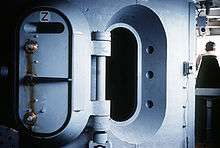
Like all battleships, the Iowas carried heavy armor protection against shellfire and bombs with significant underwater protection against torpedoes. The Iowas' "all-or-nothing" armor scheme was modeled on that of the preceding South Dakota class, and designed to give a zone of immunity against fire from 16-inch/45-caliber guns between 18,000 and 30,000 yards (16,000 and 27,000 m) away. The magazines and engine rooms were protected by an outer hull plating 1.5 inches (38 mm) thick and an armored belt 12.1 inches (310 mm) thick, which sloped at 19 degrees to give an effective vertical thickness of 13.5 inches (340 mm), laminated onto 0.875 inches (22.2 mm) thick hull plate. The turret face armor is 19.7 inches (500 mm) inches thick, and the conning tower and the turret barbettes armor is up to 17.3 inches (440 mm) thick.[19] The main belt and barbette armor consists of Class A, face-hardened Krupp cemented (K.C.) armor, while the lower belt, conning tower, and turret faces use Class B, homogeneous K.C. armor. Furthermore, Special Treatment Steel (STS), a high-tensile structural steel with armor properties comparable to Class B, is extensively used in the hull plating to increase protection.[20]
The deck armor consists of a 1.5 inches (38 mm) thick STS weather deck, a combined 6 inches (150 mm) thick Class B and STS main armored deck, and a 0.63 inches (16 mm) thick STS splinter deck. Over the magazines, the splinter deck is replaced by another 1 inch (25 mm) STS armored plate that separates the magazine from the main armored deck.[19] Missouri and Wisconsin incorporated the most significant change in armor from the South Dakota class: the increase from 11.3 inches (290 mm) to 14.5 inches (370 mm) of the vertical Class A armor on the forward transverse armored bulkhead. The extra armor provided protection from fire directly ahead, which was considered more likely given the high speed of the Iowa class. The magazine rooms are surrounded by 1.5 inches (38 mm) armored bulkheads for splinter protection.[19] The installation of armor on the Iowa-class battleships also differed from those of earlier battleships in that the armor was installed while the ships were still "on the way" rather than after the ships had been launched.[21]
The armor's immunity zone shrank considerably against guns equivalent to their own 16-inch/50-caliber guns armed with the Mark 8 "Super-heavy" APCBC shell due to the weapon's increased muzzle velocity and improved shell penetration; increasing the armor would have increased weight and reduced speed, a compromise that the General Board was not willing to make.[19]
The Iowa-class torpedo defense was virtually the same as the South Dakota's. Each side of the ship was protected below the waterline by two tanks mounted outside the belt armor, and separated by a bulkhead. These tanks were initially planned to be empty, but in practice were filled with water or fuel oil. The armored belt tapered to a thickness of 4 inches (100 mm) below the waterline. Behind the armored belt there was a void, and then another bulkhead. The outer hull was intended to detonate a torpedo, with the outer two compartments absorbing the shock and with any splinters or debris being stopped by the armored belt and the empty compartment behind it. In 1939 the Navy discovered that this system was considerably less effective than earlier torpedo defense systems, but by then it was too late to change the design.[22] Based on hard-learned lessons in the Pacific theater concerns were also raised over the ability of the armor on these battleships to withstand the effects of aerial bombing, but at the time these concerns surfaced nothing could be done to adequately address the problem.[11]
Armament
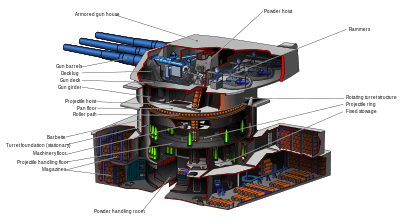
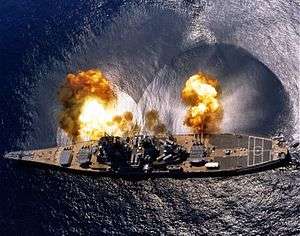
The primary guns used on these battleships are the nine 16-inch (406 mm) / 50-caliber Mark 7 naval guns, a compromise design developed to fit inside the barbettes. These guns fire explosive– and armor-piercing shells, and can fire a 16-inch (406 mm) shell approximately 23.4 nautical miles (40 km).[23][24] The guns are housed in three 3-gun turrets: two forward and one aft, in a configuration known as "2-A-1". The guns are 66 feet (20 m) long (50 times their 16-inch (410 mm) bore, or 50 calibers from breechface to muzzle). About 43 feet (13 m) protrudes from the gun house. Each gun weighs about 239,000 pounds (108,000 kg) without the breech, or 267,900 pounds (121,500 kg) with the breech.[24] They fire projectiles weighing from 1,900 to 2,700 pounds (850 to 1,200 kg) at a maximum speed of 2,960 ft/s (820 m/s) up to 20 miles (32 km). At maximum range, the projectile spends almost 1½ minutes in flight. The maximum firing rate for each gun is two rounds per minute.[25]
Each gun rests within an armored turret, but only the top of the turret protrudes above the main deck. The turret extends either four decks (Turrets 1 and 3) or five decks (Turret 2) down. The lower spaces contain rooms for handling the projectiles and storing the powder bags used to fire them. Each turret required a crew of between 85 and 110 men to operate.[24] The original cost for each turret was US$1.4 million, but this figure does not take into account the cost of the guns themselves.[24] The turrets are "three-gun", not "triple", because each barrel can be elevated independently; they can also be fired independently. The ship could fire any combination of its guns, including a broadside of all nine.
The large-caliber guns were designed to fire two different conventional 16-inch (406 mm) shells: the armor-piercing Mk. 8 round for anti-ship and anti-structure work, and the Mk. 13 high-explosive round designed for use against unarmored targets and shore bombardment.[26] Interestingly, when firing the same conventional shell, the 16"/45 caliber Mark 6 gun used by the fast battleships of the North Carolina and South Dakota classes had a slight advantage over the 16"/50 caliber Mark 7 gun when hitting deck armor—a shell from a 45 cal gun would be slower, meaning that it would have a steeper trajectory as it descended. At 35,000 yards (20 mi; 32 km), a shell from a 45 cal would strike a ship at an angle of 45.2 degrees, as opposed to 36 degrees with the 50 cal.[27] The Mark 7 had a greater maximum range over the Mark 6: 23.64 miles (38.04 km) vs 22.829 miles (36.740 km).[28][29]
In the 1950s, the W23, an adaptation of the W19 nuclear artillery shell was developed specifically for the 16-inch (406 mm) guns. The shell had an estimated yield of 15 to 20 kilotons of TNT (63,000 to 84,000 GJ),[30] and its introduction made the Iowa-class battleship's 16 in guns the world's largest nuclear artillery,[31] and made these four battleships the only U.S. Navy ships ever to have nuclear shells for naval guns.[31] Although developed for exclusive use by the battleship's guns it is not known if any of the Iowa-class battleships actually carried these shells while in active service due to the United States Navy's policy of refusing to confirm or deny the presence of nuclear weaponry aboard its ships.[30][N 2] In 1991 the United States unilaterally withdrew all of its nuclear artillery shells from service, and dismantling of the U.S. nuclear artillery inventory is said to have been completed in 2004.[33]
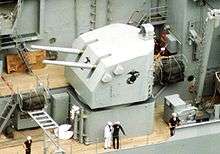
The Iowas carried ten twin enclosed base ring mounts supporting 5 in/38 caliber Mark 28 Mod 0 guns. Originally designed to be mounted upon destroyers built in the 1930s, these guns were so successful that they were added to many American ships during the Second World War, including every major ship type and many smaller warships constructed between 1934 and 1945. They were considered to be "highly reliable, robust and accurate" by the Navy's Bureau of Ordnance.[34]
Each 5 in/38 gun weighed almost 4,000 pounds (1,800 kg) without the breech; the entire mount weighed 156,295 pounds (70,894 kg). It was 223.8 inches (5,680 mm) long overall, had a bore length of 190 inches (4,800 mm) and a rifling length of 157.2 inches (3,990 mm). The gun could fire shells at about 2,500–2,600 ft/s (762–792 m/s); about 4,600 could be fired before the barrel needed to be replaced. Minimum and maximum elevations were −15 and 85 degrees respectively. The guns' elevation could be raised or lowered at about 15 degrees per second. The mounts closest to the bow and stern could aim from −150 to 150 degrees; the others were restricted to −80 to 80 degrees. They could be turned at about 25 degrees per second.[34]
The 5 in/38 cannon functioned as a dual purpose gun; that is, it was able to fire at both surface and air targets with a reasonable degree of success. However, this did not mean that it possessed inferior anti-air abilities. As proven during 1941 gunnery tests conducted aboard North Carolina the gun could consistently shoot down aircraft flying at 12,000–13,000 feet (2.3–2.5 mi; 3.7–4.0 km), twice the effective range of the earlier single purpose 5"/25 caliber anti-air gun.[34] As Japanese airplanes became faster, the gun lost some of its effectiveness in the anti-aircraft role; however, toward the end of the war its usefulness as an anti-aircraft weapon increased again because of an upgrade to the Mark 37 Fire Control System and proximity-fused shells.[35][36]
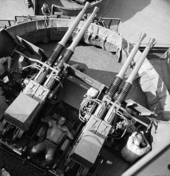
The 5 in/38 gun would remain on the battleships for the ships' entire service life; however, the total number of guns and gun mounts was reduced from 20 guns in ten mounts to 12 guns in 6 mounts during the 1980s' modernization of the four Iowas. The removal of four of the gun mounts was required for the battleships to be outfitted with the armored box launchers needed to carry and fire Tomahawk missiles. At the time of the 1991 Persian Gulf War, these guns had been largely relegated to littoral defense for the battleships. Since each battleship carried a small detachment of Marines aboard, the Marines would man one of the 5 in gun mounts.[37]
At the time of their commissioning, all four of the Iowa-class battleships were equipped with 20 quad 40 mm mounts and 49 single 20 mm mounts.[38]
The Oerlikon 20 mm anti-aircraft gun, one of the most heavily produced anti-aircraft guns of the Second World War, entered service in 1941 and replaced the 0.50"/90 (12.7 mm) M2 Browning MG on a one-for-one basis. Between December 1941 and September 1944, 32% of all Japanese aircraft downed were credited to this weapon, with the high point being 48.3% for the second half of 1942; however, the 20 mm guns were found to be ineffective against the Japanese Kamikaze attacks used during the latter half of World War II and were subsequently phased out in favor of the heavier 40 mm Bofors AA guns.[39]
When the Iowa-class battleships were commissioned in 1943 and 1944 they carried twenty quad Bofors 40 mm anti-aircraft gun mounts, which they used for defense against enemy aircraft. These heavy guns were also employed in the protection of allied aircraft carriers operating in the Pacific Theater of World War II, and accounted for roughly half of all Japanese aircraft shot down between 1 October 1944 and 1 February 1945.[40][N 3] Although successful in this role, the guns were stripped from the battleships—initially from New Jersey when reactivated in 1968[42] and later from Iowa, Missouri, and Wisconsin when they were reactivated for service in the 1980s.[N 4]
Propulsion and size


When the Second Vinson Act was passed by the United States Congress in 1938, the U.S. Navy moved quickly to develop a 45,000-ton battleship that would pass through the 110 ft (34 m) wide Panama Canal. Drawing on a 1935 empirical formula for predicting a ship's maximum speed based on scale-model studies in flumes of various hull forms and propellers[N 5] and a newly developed empirical theorem that related waterline length to maximum beam, the Navy drafted plans for a battleship class with a maximum beam of 108 ft (33 m) which, when multiplied by 7.96, produced a waterline length of 860 ft (262 m)—permitting a maximum speed of 34.9 knots (64.6 km/h).[N 6] The Navy also called for the class to have a lengthened forecastle and amidship, which would increase speed, and a bulbous bow.[46] The Iowas were to be outfitted with four screws: the outer pair consisting of two four-bladed propellers roughly 18 feet (5.5 m) in diameter and the inboard screws that have five blades and are roughly 17.5 feet (5.3 m) in diameter. The propeller designs were adopted after earlier testing had determined that propeller cavitation caused a drop in efficiency at speeds over 30 knots (56 km/h).[47] The engineering plant on Iowa and Missouri consisted of four General Electric cross-compound steam turbine engines, each driving a single shaft. The equivalent machinery on New Jersey and Wisconsin was provided by Westinghouse.[48]
Four fire rooms contained eight Babcock & Wilcox M-Type boilers operating at 600 pounds per square inch (4,137 kPa; 42 kgf/cm2)[49] with a maximum superheater outlet temperature of 875 °F (468 °C). Steam was normally transmitted to four engine rooms numbered 1 to 4. Each engine room was aft of its associated fire room. In normal steaming four boilers were operated; this was sufficient to power the ships at speeds up to 27 knots (50 km/h; 31 mph). For higher speeds, all eight boilers were lit.
Electricity drove many systems aboard ship, including rotating the turrets and elevating the guns. Each of the four engine rooms had a pair of Ship's Service Turbine Generators (SSTGs)[50] manufactured by Westinghouse. Each SSTG generated 1.25 MW for a total of 10 MW of electricity. The SSTGs were powered by steam from the same boilers that fed the engines. To allow battle-damaged electrical circuits to be repaired or bypassed, the lower decks of the ship had a Casualty Power System whose large three-wire cables and wall outlets (called "biscuits") could be used to re-route power.[51]
Aircraft (1943–69)
When they were commissioned during World War II, the Iowa-class battleships came equipped with two aircraft catapults designed to launch floatplanes. Initially, the Iowas carried the Vought OS2U Kingfisher[52] and Curtiss SC Seahawk,[52][53] both of which were employed to spot for the battleship's main gun batteries—and, in a secondary capacity, perform search-and-rescue missions.
By the time of the Korean War, helicopters had replaced floatplanes and the Sikorsky HO3S-1 helicopter was employed.[52] In time, the newer UH-1 Iroquois, SH-2 Seasprites, CH-46 Sea Knight, CH-53 Sea Stallion and the SH-60B Seahawk LAMPS III would serve aboard the battleships. In addition, New Jersey made use of the Gyrodyne QH-50 DASH drone for her Vietnam war deployment in 1968–1969.[54]
Conversion proposals
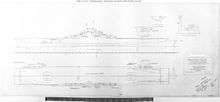
The Iowa class were the only battleships with the speed required for post-war operations based around fast aircraft carrier task forces.[55] There were a number of proposals in the early Cold War to convert the class to take into account changes in technology and doctrine. These included plans to equip the class with nuclear missiles, add aircraft capability and—in the case of Illinois and Kentucky—a proposal to rebuild both as aircraft carriers instead of battleships.[56][57][58]
Initially, the Iowa class was to consist of only four battleships: Iowa, New Jersey, Missouri, and Wisconsin. However, changing priorities during World War II resulted in the battleships Montana and Ohio being reordered as Illinois and Kentucky respectively. At the time these two battleships were to be built a proposal was put forth to have them constructed as aircraft carriers rather than fast battleships. The plan called for the ships to be rebuilt to include a flight deck and an armament suite similar to that placed aboard the Essex-class aircraft carriers that were at the time under construction in the United States.[56][57][58] Ultimately, nothing came of the design proposal to rebuild these two ships as aircraft carriers and they were cleared for construction as fast battleships to conform to the Iowa-class design, though they differed from the earlier four that were built. Eventually, the Cleveland-class light cruisers were selected for the aircraft-carrier conversion. Nine of these light cruisers would be rebuilt as Independence-class light aircraft carriers.[59]
After the surrender of the Empire of Japan, construction on Illinois and Kentucky stopped. Illinois was eventually scrapped, but Kentucky's construction had advanced enough that several plans were proposed to complete Kentucky as a guided missile battleship (BBG) by removing the aft turret and installing a missile system.[60][61] A similar conversion had already been performed on the battleship Mississippi (BB-41/AG-128) to test the RIM-2 Terrier missile after World War II.[62] One such proposal came from Rear Admiral W. K. Mendenhall, Chairman of the Ship[s] Characteristics Board (SCB); Mendehall proposed a plan that called for $15–$30 million to be spent to allow Kentucky to be completed as a guided-missile battleship (BBG) carrying eight SSM-N-8 Regulus II guided missiles with a range of 1,000 nautical miles (1,900 km; 1,200 mi). He also suggested Terrier or RIM-8 Talos launchers to supplement the AA guns and proposed nuclear (instead of conventional) shells for the 16-inch guns.[63] This never materialized,[64] and Kentucky was ultimately sold for scrap in 1958, although her bow was used to repair her sister Wisconsin after a collision.[60]
In 1954 the Long Range Objectives Group of the United States Navy suggested converting the Iowa-class ships to BBGs. In 1958 the Bureau of Ships offered a proposal based on this idea. This replaced the 5-inch and 16-inch gun batteries with "two Talos twin missile systems, two RIM-24 Tartar twin missile systems, an RUR-5 ASROC antisubmarine missile launcher, and a Regulus II installation with four missiles",[65] as well as flagship facilities, sonar, helicopters, and fire-control systems for the Talos and Tartar missiles. In addition to these upgrades, 8,600 additional [long] tons of fuel oil was also suggested to serve in part as ballast for the battleships and for use in refueling destroyers and cruisers. Due to the estimated cost of the overhaul ($178–$193 million) this proposal was rejected as too expensive; instead, the SCB suggested a design with one Talos, one Tartar, one ASROC and two Regulus launchers and changes to the superstructure, at a cost of up to $85 million. This design was later revised to accommodate the Polaris Fleet Ballistic Missile, which in turn resulted in a study of two schemes by the SCB. In the end, none of these proposed conversions for the battleships were ever authorized.[66] Interest in converting the Iowa-class battleships into guided-missile battleships began to deteriorate in 1960, because the hulls were considered too old and the conversion costs too high.[67] Nonetheless, additional conversion proposals—including one to install the AN/SPY-1 Aegis Combat System radar[64] on the battleships—were suggested in 1962, 1974 and 1977 but as before, these proposals failed to gain the needed authorization.[68] This was due, in part, to the fact that sensitive electronics within 200 ft of any 16-inch gun muzzle were likely to be damaged.[67]
1980s refit
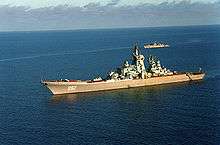
In 1980, Ronald Reagan was elected President, with a plan to rebuild the U.S. military as a counter to the increasing military power of the Soviet Union as one of his benchmark commitments. At the time, the Soviet Navy was in the process of commissioning a class of missile cruiser the like of which had not been seen for decades – the Kirov class was the largest type of surface warship (other than aircraft carriers or amphibious assault vessels) built since World War II, and the Americans had not envisioned building anything like it. As a consequence, as part of Reagan's 600-ship Navy policy and to act as a counter to the Kirov class, the U.S. Navy began the process of reactivating the four Iowa-class units and modernizing them for service in the 1980s.[69][70]
During this reactivation, the Navy considered several concepts entailing removal of the aft 16-inch turret. Martin Marietta proposed to replace the turret with servicing facilities for 12 AV-8B Harrier STOVL jumpjets. Charles Myers proposed replacement of the turret with vertical launch systems for missiles and a flight deck for Marine helicopters. Naval Institute Proceedings proposed a canted flight deck (complete with a steam catapult) and arrestor wires to operate F/A-18 Hornet fighters. Plans for these conversions were dropped in 1984,[71] but each battleship was overhauled to burn navy distillate fuel and modernized to carry electronic warfare suites, close-in weapon systems (CIWS) for self-defense, and missiles.[64] It was determined that the total cost of reactivating and modernising one battleship was roughly the same as the cost of building a new Oliver Hazard Perry-class frigate.[72]
After recommissioning, the modernized battleships operated as centerpieces of their own battle group (termed as a Battleship Battle Group or Surface Action Group), consisting of one Ticonderoga-class cruiser, one Kidd-class destroyer or Arleigh Burke-class destroyer, one Spruance-class destroyer, three Oliver Hazard Perry-class frigates and one support ship, such as a fleet oiler.[73]
Armament
During their modernization in the 1980s each Iowa-class battleship was equipped with four of the US Navy's Phalanx CIWS mounts, two of which sat just behind the bridge and two which were next to the after ship's funnel. Iowa, New Jersey, and Missouri were equipped with the Block 0 version of the Phalanx, while Wisconsin received the first operational Block 1 version in 1988.[74] The Phalanx system is intended to serve as a last line of defense against enemy missiles and aircraft, and when activated can engage a target with a 20 mm (0.79 in) M61 Vulcan 6-barreled Gatling cannon[75] at a distance of approximately 4,000 yards (3.7 km).[74]
As part of their modernization in the 1980s, each of the Iowa-class battleships received a complement of Armored Box Launchers and "shock hardened" Mk. 141 quad cell launchers. The former was used by the battleships to carry and fire the BGM-109 Tomahawk Land Attack Missiles (TLAMs) for use against enemy targets on land, while the latter system enabled the ships to carry a complement of RGM-84 Harpoon anti-ship missiles for use against enemy ships. With an estimated range of 675 nautical miles (1,250 km; 777 mi) to 1,500 nautical miles (2,800 km; 1,700 mi)[76] for the Tomahawk missile and 64.5 nautical miles (119.5 km; 74.2 mi) to 85.5 nautical miles (158.3 km; 98.4 mi)[76] for the Harpoon missile system, these two missile systems displaced the sixteen-inch guns and their maximum range of 42,345 yards (38,720 m) (24.06 mi)[24] to become the longest-ranged weapons on the battleships during the 1980s. It has been alleged by members of the environmental group Greenpeace[77][78][79] that the battleships carried the TLAM-A (also cited, incorrectly, as the TLAM-N)—a Tomahawk missile with a variable yield W80 nuclear warhead—during their 1980s service with the United States Navy, but owing to the United States Navy's policy of refusing to confirm or deny the presence of nuclear weaponry aboard its ships, these claims can not be conclusively proved.[30][N 2] Between 2010 and 2013, the U.S. withdrew the BGM-109A, leaving only conventional munitions packages for its Tomahawk Missile inventory.[80]
Owing to the original 1938 design of the battleships, the Tomahawk missiles could not be fitted to the Iowa class unless the battleships were rebuilt in such a way as to accommodate the missile mounts that would be needed to store and launch the Tomahawks. This realization prompted the removal of the anti-aircraft guns previously installed on the Iowas and the removal of four of each of the battleships' ten 5"/38 DP mounts. The mid and aft end of the battleships were then rebuilt to accommodate the missile magazines. At one point, the NATO Sea Sparrow was to be installed on the reactivated battleships; however, it was determined that the system could not withstand the overpressure effects from firing the main battery.[81] To supplement the anti-aircraft capabilities of the Iowas, five FIM-92 Stinger surface-to-air missile firing positions were installed. These secured the shoulder-launched weapons and their rounds for ready use by the crew.[76]
Electronics
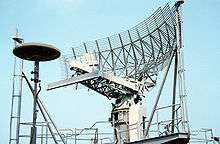

The earliest search radars installed were the SK air-search radar and SG surface-search radar during World War II. They were located on the mainmast and forward fire-control tower of the battleships, respectively. As the war drew to a close, the United States introduced the SK-2 air-search radar and SG surface-search radar; the Iowa class was updated to make use of these systems between 1945 and 1952. At the same time, the ships' radar systems were augmented with the installation of the SP height finder on the main mast. In 1952, AN/SPS-10 surface-search radar and AN/SPS-6 air-search radar replaced the SK and SG radar systems, respectively. Two years later the SP height finder was replaced by the AN/SPS-8 height finder, which was installed on the main mast of the battleships. During their brief period of activity under the 600-ship Navy program, the battleships' radar systems were again upgraded. The AN/SPS-6 air-search radar system was replaced with the AN/SPS-49 radar set (which also augmented the existing navigation capabilities on the battleships), and the AN/SPS-8 ground-search radar set was replaced by the AN/SPS-67 search radar.[52]
In addition to these search and navigational radars, the Iowa class were also outfitted with a variety of fire control systems for their gun systems, and later for their missile systems. Beginning with their commissioning, the battleships made use of a trio of Mk 38 gun fire control systems to direct the 16-inch guns and a quartet of Mk 37 gun fire control systems to direct the 5 in gun batteries. These systems were upgraded over time, but remained the cornerstones of the combat radar systems on the Iowa class during their careers.[82] The range estimation of these gunfire control systems provided a significant accuracy advantage over earlier ships with optical rangefinders; this was demonstrated off Truk Atoll on 16 February 1944 when Iowa engaged the Japanese destroyer Nowaki at a range of 35,700 yards (32.6 km) and straddled her, setting the record for the longest-ranged straddle in history.[83]
Initially, the battleships made use of a mass collection of 20 mm and 40 mm guns for anti-aircraft (AA) operations; these guns were respectively augmented with the Mk 14 range sight and Mk 51 fire control system to improve accuracy. By the Korean War, jet engines had replaced propellers on aircraft, which severely limited the ability of the AA batteries and their gun systems to track and shoot down enemy planes. Consequently, the AA guns and their associated fire-control systems were removed when reactivated. New Jersey received this treatment in 1967, and the others followed in their 1980s modernizations. In the 1980s, each ship also received a quartet of Phalanx Close in Weapon System (CIWS) mounts which made use of a radar system to locate incoming enemy projectiles and destroy them with a 20 mm Gatling gun before they could strike the ship.[82][84]
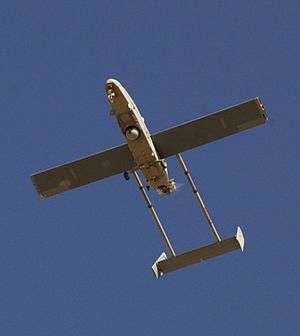
With the added missile capacity of the battleships in the 1980s came additional fire-support systems to launch and guide the ordnance. To fire the Harpoon anti-ship missiles, the battleships were equipped with the SWG-1 fire-control system, and to fire the Tomahawk missiles the battleships used either the SWG-2 or SWG-3 fire-control system. In addition to these offensive-weapon systems, the battleships were outfitted with the AN/SLQ-25 Nixie to be used as a lure against enemy torpedoes, an SLQ-32 electronic warfare system that can detect, jam, and deceive an opponent's radar and a Mark 36 SRBOC system to fire chaff rockets intended to confuse enemy missiles.[82][84]
Aside from the electronics added for weaponry control, all four battleships were outfitted with a communications suite used by both cruisers and guided missile cruisers in service at the time.[64] This communication suite included the OE-82 antenna for satellite communications,[85] but did not include the Naval Tactical Data System.[64]
Aircraft (1982–92)

During the 1980s these battleships made use of the RQ-2 Pioneer, an unmanned aerial vehicle employed in spotting for the guns. Launched from the fantail using a rocket-assist booster that was discarded shortly after takeoff, the Pioneer carried a video camera in a pod under the belly of the aircraft which transmitted live video to the ship so operators could observe enemy actions or fall of shot during naval gunnery. To land the UAV a large net was deployed at the back of the ship; the aircraft was flown into it. Missouri and Wisconsin both used the Pioneer UAVs successfully during Operation Desert Storm, and in one particularly memorable incident,[86] a Pioneer UAV operated by Wisconsin received the surrender of Iraqi troops during combat operations.[86] This particular Pioneer was later donated to the Smithsonian Institution, and is now on public display.[87] During Operation Desert Storm these Pioneers were operated by detachments of VC-6.[88] In addition to the Pioneer UAVs, the recommissioned Iowas could support six types of helicopters: the Sikorsky HO3S-1,[52] UH-1 Iroquois, SH-2 Seasprites, CH-46 Sea Knight, CH-53 Sea Stallion and the LAMPS III SH-60B Seahawk.
Gunfire support role
Following the 1991 Gulf War and the subsequent dissolution of the Soviet Union, the United States Navy began to decommission and mothball many of the ships it had brought out of its reserve fleet in the drive to attain a 600-ship Navy. At the height of Navy Secretary John F. Lehman's 600-ship Navy plan, nearly 600 ships of all types were active within the Navy. This included fifteen aircraft carriers, four battleships and over 100 submarines, along with various other types of ships the overall plan specified. When the Soviet Union collapsed in 1991 the Navy sought to return to its traditional, 313-ship composition.[89] While reducing the fleet created under the 600-ship Navy program, the decision was made to deactivate the four recommissioned Iowa-class battleships and return them to the reserve fleet.[N 7]
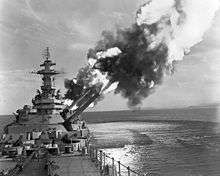
In 1995, the decommissioned battleships were removed from the Naval Vessel Register (NVR) after it was determined by ranking US Navy officials that there was no place for a battleship in the modern navy.[54] In response to the striking of the battleships from the Naval Vessel Register a movement began to reinstate the battleships, on the grounds that these vessels had superior firepower over the then-existing 5 in guns found on the Spruance-class destroyers, Kidd-class destroyers, Arleigh Burke-class destroyers, and Ticonderoga-class cruisers.[91] Citing concern over the lack of available gunfire to support amphibious operations, Congress demanded that the United States Navy reinstate two battleships to the naval vessel register[54] and maintain them with the mothball fleet, until the Navy could certify it had gunfire support within the current fleet that would meet or exceed the battleship's capability.[92]
The debate over battleships in the modern navy continued until 2006, when the two reinstated battleships were stricken after naval officials submitted a two-part plan that called for the near-term goal of increasing the range of the guns currently in use on the Flight I Arleigh Burke-class destroyers with specially designed ammunition intended to allow a five-inch projectile fired from these guns to travel an estimated 40 nautical miles (70 km) inland.[93][94] The long-term goal calls for the replacement of the two battleships with vessels of the Zumwalt class of guided-missile destroyers. These ships are to be outfitted with an advanced gun system (AGS) that will fire specially developed 6 in Long Range Land Attack Projectiles for shore bombardment;[95] however, the long-term goal for the Zumwalt class is to have the ships mount railguns or free-electron lasers.[96][97][N 8]
Cultural significance
_arrives_in_Pearl_Harbor.jpg)
The Iowa class has become culturally symbolic in the United States in many different ways, to the point where certain elements of the American public—such as the United States Naval Fire Support Association—are unwilling to part with the battleships despite their apparent obsolescence in the face of modern naval combat doctrine that places great emphasis on air supremacy and missile firepower. Although all have been officially stricken from the Naval Vessel Register they have been spared scrapping and were donated for use as museum ships.[99][100][101][102]
Their service records have added to their fame, ranging from their work as carrier escorts in World War II to their shore bombardment duties in North Korea, North Vietnam, and the Middle East, as well as their service in the Cold War against the expanded Soviet Navy.[N 9] Their reputation combined with the stories told concerning the firepower of these battleships' 16 inch guns[105] are such that when they were brought out of retirement in the 1980s in response to increased Soviet Naval activity—and in particular, in response to the commissioning of the Kirov-class battlecruisers[69][70]—the United States Navy was inundated with requests from former sailors pleading for a recall to active duty so they could serve aboard one of the battleships.[106]
In part because of the service length and record of the class, members have made numerous appearances in television shows, video games, movies, and other media, including appearances in the anime series Neon Genesis Evangelion,[107] the History Channel documentary series Battle 360: USS Enterprise, [108] the Discovery Channel documentary The Top 10 Fighting Ships (where the Iowa class was rated Number 1),[109] the stealth action game Metal Gear Solid 4: Guns of the Patriots,[110] the Real Time Tactics game World in Conflict,[111] the book turned movie A Glimpse of Hell,[112][113] the 1989 song by Cher If I Could Turn Back Time,[114] the 1992 film Under Siege,[115] and the 2012 film Battleship,[116] among other appearances. Japanese rock band Vamps performed the finale of their 2009 US tour on board the USS Missouri on 19 September 2009.[117]
Ships
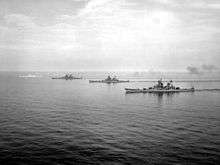
When brought into service during the final years of World War II, the Iowa-class battleships were assigned to operate in the Pacific Theatre of World War II. By this point in the war, aircraft carriers had displaced battleships as the primary striking arm of both the United States Navy and the Imperial Japanese Navy. As a result of this shift in tactics, U.S. fast battleships of all classes were relegated to the secondary role of carrier escorts and assigned to the Fast Carrier Task Force to provide anti-aircraft screening for U.S. aircraft carriers and perform shore bombardment.[118] Three were recalled to service in the 1950s with the outbreak of the Korean War,[N 10] and provided naval artillery support for U.N. forces for the entire duration of the war before being returned to mothballs in 1955 after hostilities ceased. In 1968, to help alleviate U.S. air losses over North Vietnam,[119] New Jersey was summoned to Vietnam, but was decommissioned a year after arriving.[120][121][122] All four returned in the 1980s during the drive for a 600-ship Navy to counter the new Soviet Kirov-class battlecruisers,[69][70] only to be retired after the collapse of the Soviet Union on the grounds that they were too expensive to maintain.[90][N 11]
| Ship name | Hull no. | Builder | Ordered | Laid down | Launched | Commissioned | Decommissioned | Fate |
|---|---|---|---|---|---|---|---|---|
| Iowa | BB-61 | Brooklyn Navy Yard, New York City | 1 July 1939 | 27 June 1940 | 27 August 1942 | 22 February 1943 | 24 March 1949 | Preserved as museum ship in Los Angeles, California |
| 25 August 1951 | 24 February 1958 | |||||||
| 28 April 1984 | 26 October 1990 | |||||||
| New Jersey | BB-62 | Navy Yard, Philadelphia | 16 September 1940 | 7 December 1942 | 23 May 1943 | 30 June 1948 | Preserved as museum ship in Camden, New Jersey | |
| 21 November 1950 | 21 August 1957 | |||||||
| 6 April 1968 | 17 December 1969 | |||||||
| 28 December 1982 | 8 February 1991 | |||||||
| Missouri | BB-63 | Brooklyn Navy Yard, New York City | 12 June 1940 | 6 January 1941 | 29 January 1944 | 11 June 1944 | 26 February 1955 | Preserved as museum ship in Pearl Harbor, Hawaii |
| 10 May 1986 | 1 March 1992 | |||||||
| Wisconsin | BB-64 | Navy Yard, Philadelphia | 25 January 1941 | 7 December 1943 | 16 April 1944 | 1 July 1948 | Preserved as museum ship in Norfolk, Virginia | |
| 3 March 1951 | 8 March 1958 | |||||||
| 22 October 1988 | 30 September 1991 | |||||||
| Illinois | BB-65 | 9 September 1940 | 6 December 1942 | N/A | Cancelled 11 August 1945 Broken up at Philadelphia, 1958 | |||
| Kentucky | BB-66 | Norfolk Navy Yard, Portsmouth | 7 March 1942 | 20 January 1950 | N/A | Broken up at Baltimore, 1959 | ||
| BBG-1 | ||||||||
1. ^ Kentucky was not officially launched; her hull was moved from drydock to allow Missouri to be admitted for repairs following her grounding.
Iowa
_firing_her_406_mm_guns_at_North_Korean_coastal_defenses_in_1952.jpg)
Iowa was ordered 1 July 1939, laid down 27 June 1940, launched 27 August 1942, and commissioned 22 February 1943. She conducted a shakedown cruise in Chesapeake Bay before sailing to Naval Station Argentia, Newfoundland, to be ready in case the German battleship Tirpitz entered the Atlantic.[123] Transferred to the Pacific Fleet in 1944, Iowa made her combat debut in February and participated in the campaign for the Marshall Islands.[124] The ship later escorted U.S. aircraft carriers conducting air raids in the Marianas campaign, and then was present at the Battle of Leyte Gulf.[124] During the Korean War, Iowa bombarded enemy targets at Songjin, Hŭngnam, and Kojo, North Korea. Iowa returned to the U.S. for operational and training exercises before being decommissioned on 24 February 1958.[125] Reactivated in the early 1980s, Iowa operated in the Atlantic Fleet, cruising in North American and European waters for most of the decade and participating in joint military exercises with European ships.[126] On 19 April 1989, 47 sailors were killed following an explosion in her No. 2 turret.[127] In 1990, Iowa was decommissioned for the last time and placed in the mothball fleet. She was stricken from the Naval Vessel Register on 17 March 2006. Iowa was anchored as part of the National Defense Reserve Fleet in Suisun Bay, California until October 2011, when she was towed from her mooring to Richmond, California for renovation as a museum ship. She was towed from Richmond in the San Francisco Bay on 26 May 2012, to San Pedro at the Los Angeles Waterfront to serve as a museum ship run by Pacific Battleship Center and opened to the public on 7 July 2012.
New Jersey
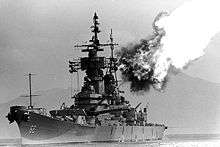
New Jersey was ordered 4 July 1939, laid down 16 September 1940, launched 7 December 1942, and commissioned 23 May 1943. New Jersey completed fitting out and trained her initial crew in the Western Atlantic and Caribbean before transferring to the Pacific Theatre in advance of the planned assault on the Marshall Islands, where she screened the U.S. fleet of aircraft carriers from enemy air raids. At the Battle of Leyte Gulf, the ship protected carriers with her anti-aircraft guns. New Jersey then bombarded Iwo Jima and Okinawa. During the Korean War, the ship pounded targets at Wonsan, Yangyang, and Kansong. Following the Armistice, New Jersey conducted training and operation cruises until she was decommissioned. Recalled to duty in 1968, New Jersey reported to the gunline off the Vietnamese coast, and shelled North Vietnamese targets before departing the line in December 1968.[120] She was decommissioned the following year.[121] Reactivated in 1982 under the 600-ship Navy program,[128] New Jersey was sent to Lebanon to protect U.S. interests and U.S. Marines, firing her main guns at Druze and Syrian positions in the Beqaa Valley east of Beirut.[129] Decommissioned for the last time 8 February 1991, New Jersey was briefly retained on the Naval Vessel Register before being donated to the Home Port Alliance of Camden, New Jersey for use as a museum ship in October 2001.[130]
Missouri
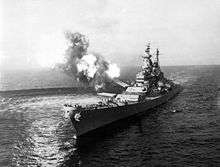
The Missouri was the last of the four Iowa-class battleships to be completed. She was ordered 12 June 1940, laid down 6 January 1941, launched 29 January 1944, and commissioned 11 June 1944. Missouri conducted her trials off New York with shakedown and battle practice in Chesapeake Bay before transferring to the Pacific Fleet, where she screened U.S. aircraft carriers involved in offensive operations against the Japanese before reporting to Okinawa to shell the island in advance of the planned landings. Following the bombardment of Okinawa, Missouri turned her attention to the Japanese homeland islands of Honshu and Hokkaido, performing shore bombardment and screening U.S. carriers involved in combat operations. She became a symbol of the U.S. Navy's victory in the Pacific when representatives of the Empire of Japan boarded the battleship to sign the documents of unconditional surrender to the Allied powers in September 1945. After World War II, Missouri conducted largely uneventful training and operational cruises until suffering a grounding accident. In 1950 she was dispatched to Korea in response to the outbreak of the Korean War. Missouri served two tours of duty in Korea providing shore bombardment. She was decommissioned in 1956. She spent many years at Puget Sound Naval Shipyard in Bremerton, Washington. Reactivated in 1984 as part of the 600-ship Navy plan, Missouri was sent on operational cruises until being assigned to Operation Earnest Will in 1988. In 1991, Missouri participated in Operation Desert Storm, firing 28 Tomahawk Missiles and 759 sixteen-inch (406 mm) shells at Iraqi targets along the coast.[120][131] Decommissioned for the last time in 1992, Missouri was donated to the USS Missouri Memorial Association of Pearl Harbor, Hawaii, for use as a museum ship in 1999.[132]
Wisconsin
_launching_Tomahawk.jpg)
Wisconsin was ordered 12 June 1940, laid down 25 January 1942, launched 7 December 1943, and commissioned 16 April 1944. After trials and initial training in Chesapeake Bay, she transferred to the Pacific Fleet in 1944 and was assigned to protect the U.S. fleet of aircraft carriers involved in operations in the Philippines until summoned to Iwo Jima to bombard the island in advance of the Marine landings. Afterward, she proceeded to Okinawa, bombarding the island in advance of the allied amphibious assault. In mid-1945 Wisconsin turned her attention to bombarding the Japanese home islands until the surrender of Japan in August. Reactivated in 1950 for the Korean War, Wisconsin served two tours of duty, assisting South Korean and UN forces by providing call fire support and shelling targets. In 1956, the bow of the uncompleted USS Kentucky was removed and grafted on Wisconsin, which had collided with the destroyer USS Eaton.[133] Decommissioned in 1958, Wisconsin was placed in the reserve fleet at the Philadelphia Naval Shipyard until reactivated in 1986 as part of the 600-ship Navy plan.[134] In 1991, Wisconsin participated in Operation Desert Storm, firing 24 Tomahawk Missiles at Iraqi targets, and expending 319 16-inch (406 mm) shells[120] at Iraqi troop formations along the coast. Decommissioned for the last time 30 September 1991, Wisconsin was placed in the reserve fleet until stricken from the Naval Vessel Register on 17 March 2006 so she could be transferred for use as a museum ship. Wisconsin is currently berthed at the Nauticus maritime museum in Norfolk, Virginia.[134]
Illinois and Kentucky

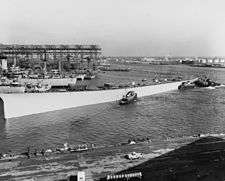
Hull numbers BB-65 and BB-66 were originally intended as the first and second ships of the Montana-class of battleships;[135] however the passage of an emergency war building program on 19 July 1940 resulted in both hulls being reordered as Iowa-class units to save time on construction.[136][137] The war ended before either could be completed, and work was eventually stopped. Initially, proposals were made to convert the hulls into aircraft carriers similar to the Essex-class, but the effort was dropped.[56][57][58] Eventually both hulls were scrapped.
Illinois was ordered on 9 September 1940 and initially laid down on 6 December 1942. However, work was suspended pending a decision on whether to convert the hull to an aircraft carrier. Upon determination the result would cost more and be less capable than building from scratch construction resumed, but was canceled for good approximately one-quarter complete on 11 August 1945.[138] She was sold for scrap and broken up on the slipway in September 1958.[139][140]
Kentucky was ordered on 9 September 1940 and laid down on 7 March 1942. Work on the ship was suspended in June 1942, and the hull floated out to make room for the construction of LSTs.[141] The interruption lasted for two and a half years while a parallel aircraft carrier debate played out as with the Illinois, reaching the same conclusion. Work resumed in December 1944, with completion projected for mid-1946. Further suggestions were made to convert Kentucky into a specialist anti-aircraft ship, and work was again suspended. With the hull approximately three-quarters completed she was floated on 20 January 1950 to clear a dry-dock for repairs to Missouri, which had run aground. During this period, plans were proposed to convert Kentucky into a guided missile battleship, which saw her reclassified from BB-66 to BBG-1.[135][136] When these failed construction of any sort never resumed and the ship was used as a parts hulk; in 1956, her bow was removed and shipped in one piece across Hampton Roads and grafted onto Wisconsin, which had collided with the destroyer Eaton.[134] In 1958, the engines installed on Kentucky were salvaged and installed on the Sacramento-class fast combat support ships Sacramento and Camden.[135] Ultimately, what remained of the hulk was sold for scrap on 31 October 1958.[125]
Notes
- ↑ The belt armor was increased from 8.1 inches (210 mm) to 12.6 inches (320 mm); the deck from 2.3 inches (58 mm) to 5 inches (130 mm); the splinter armor to 3.9 inches (99 mm); the turret armor from 9 inches (230 mm) on the front, 6 inches (150 mm) on the side, and 5 inches (130 mm) on the rear to 18 inches (460 mm), 10 inches (250 mm) and 8 inches (200 mm), respectively.[5]
- 1 2 "Military members and civilian employees of the Department of the Navy shall not reveal, report to reveal, or cause to be revealed any information, rumor, or speculation with respect to the presence or absence of nuclear weapons or components aboard any specific ship, station or aircraft, either on their own initiative or in response, direct or indirect, to any inquiry. [...] The Operations Coordinating Board (part of President Eisenhower's National Security Council) established the U.S. policy in 1958 of neither confirming nor denying (NCND) the presence or absence of nuclear weapons at any general or specific location, including aboard any U.S. military station, ship, vehicle, or aircraft."[32]
- ↑ In early 1945, the United States Navy determined that these 40 mm guns were also inadequate for defense against Japanese kamikaze attacks in the Pacific Theater, and subsequently began to replace the Bofors guns with a 3"/50 caliber gun capable of using variable time (VT) charges.[40][41]
- ↑ "As part of their modernizations, the Iowa-class vessels lost their antiaircraft batteries in favor of Phalanx Close in Weapon Systems and several of their 5in/38cal guns to make room for the launchers for the TLAMs and Harpoons."[43]
- ↑ These mathematical formulas still stand today, and have been used to design hulls for U.S. ships and to predict the speed of those hulls for the ships when commissioned, including nuclear powered ships like the U.S. fleet of Nimitz-class supercarriers.[44]
- ↑ The actual speed of the Iowa-class battleships varies from source to source. The most commonly cited figures for the battleship class are 32 or 33 knots (61 km/h), but it appears that such speeds have never actually been attained in speed tests. Theoretically, the battleships of the Iowa class should be able to cruise at nearly 35 knots (65 km/h), but this speed appears to be abnormally high and does not take into account factors like ocean resistance and weight. The fastest confirmed speed for the class is just over 31 knots (57 km/h), a speed attained by New Jersey during tests.[45]
- ↑ "As stated in our testimony, there is current pressure to greatly reduce the defense budget, which led to the decision to retire two battleships. Because the battleships are costly to maintain (about $58 million to operate annually, according to the Navy) and difficult to man, and because of the unanswered safety and missions-related questions, the two remaining battleships seem to be top candidates for decommissioning as the United States looks for ways to scale back its forces. If the Navy also decommissions the remaining two battleships, the Navy’s entire $33 million request for 16-inch ammunition could be denied, and the $4.4 million request for 5inch/38caliber gun ammunition could reduced by $3.6 million."[90]
- ↑ The expected performance of the current rail gun design is a muzzle velocity over 5,800 m/s, accurate enough to hit a 5 meter target over 200 nautical miles (370.4 kilometres (370,400 m)) away while firing at 10 shots per minute.[98]
- ↑ Praise for the service of these battleships include comments from shore parties observing the battleships' bombardments during their wartime service, such as those received by New Jersey in the Korean War and the Vietnam War.[103] When reactivated in the 1980s Admiral of the Fleet of the Soviet Union Sergey Gorshkov stated that the battleships "...are in fact the most to be feared in [America's] entire naval arsenal..." and that the Soviet's weaponry "...would bounce off or be of little effect..." against the Iowa-class battleships.[104]
- ↑ Missouri had not been mothballed prior to the outbreak of the Korean War due to an executive order issued by then President Harry S. Truman.
- ↑ A Government Accountability Office report on the operating cost for each individual Iowa-class battleship in 1991 reported that it cost the United States Navy $58 million to operate each individual battleship.[90]
References
- ↑ Hough, pp. 214–216.
- ↑ Garzke and Dulin, p. 107.
- ↑ Friedman, pp. 309, 311.
- ↑ Friedman, p. 309.
- 1 2 Friedman, p. 310.
- ↑ Friedman, pp. 271, 309.
- ↑ Friedman, pp. 309–310.
- ↑ Friedman, pp. 310–311.
- ↑ Friedman, p. 311.
- ↑ Friedman, pp. 311–312.
- 1 2 Lyon, p. 240.
- 1 2 Rogers: Fastest Battleships
- ↑ Vinson: Congressional biography
- ↑ Newhart, p. 92.
- ↑ Stillwell, p. 16.
- ↑ Friedman, p. 313.
- ↑ Friedman, pp. 313–314.
- ↑ Friedman, p. 307.
- 1 2 3 4 Friedman, p. 314.
- ↑ TABLE OF METALLURGICAL PROPERTIES OF NAVAL ARMOR AND CONSTRUCTION MATERIALS. Nathan Okun
- ↑ Stillwell, p. 15.
- ↑ Friedman, p. 285.
- ↑ Thompson, pp. 70–81.
- 1 2 3 4 5 DiGiulian, Tony (22 November 2009). "United States of America 16"/50 (40.6 cm) Mark 7". Navweaps.com. Retrieved 23 January 2010.
- ↑ Poyer, pp. 50–53.
- ↑ Sumrall, pp. 73–76.
- ↑ DiGiulian, "United States of America 16"/45 (40.6 cm) Mark 6"
- ↑ Tony DiGiulian. "USA 16"/45 (40.6 cm) Mark 6". Navweaps.com. Retrieved 2012-08-07.
- ↑ "Battleship Comparison". Combinedfleet.com. Retrieved 2012-08-07.
- 1 2 3 Yenne, pp. 132–133.
- 1 2 Polmar, p. 490.
- ↑ Morgan, J. G., JR. (3 February 2006). "Release of Information on Nuclear Weapons and on Nuclear Capabilities of U.S. Forces (OPNAVINST 5721.1F N5GP)" (PDF). Washington, D.C.: Department of the Navy — Office of the Chief of Naval Operations. pp. 1–2. Retrieved 2012-07-02.
- ↑ DeVolpi, p. VA-13.
- 1 2 3 DiGiulian, "United States of America 5"/38 (12.7 cm) Mark 12"
- ↑ Stillwell, 1996, p. 256.
- ↑ Sumrall, p. 80.
- ↑ Wass, p. 27.
- ↑ Terzibaschitsch, pp. 147–153.
- ↑ DiGiulian, "United States of America 20 mm/70 (0.79") Marks 2, 3 & 4"
- 1 2 Digiulian, "United States of America 40 mm/56 (1.57") Mark 1, Mark 2, and M1"
- ↑ DiGiulian, "United States of America 3"/50 (7.62 cm) Marks 27, 33 and 34"
- ↑ Garzke and Dulin, p. 139.
- ↑ Nauticus. "National Register of Historic Places Registration Form" (PDF) (Official United States Government Document). United States Department of the Interior. p. 11. Retrieved 2012-11-28.
- ↑ Davis, p. 15.
- ↑ Friedman, p. 317.
- ↑ Davis, p. 10.
- ↑ Davis, pp. 5–6.
- ↑ Preston, p. 259.
- ↑ Stillwell, p. 22.
- ↑ For a diagram and statistics of SSTGs, see: Hochscheidt, Mike. "Ship's Service Turbine Generator". Retrieved 16 December 2010.
- ↑ Defense Technical Information Center. "Casualty power (DOC)". United States Department of Defense. Retrieved 16 December 2010.
- 1 2 3 4 5 Stillwell, p. 296.
- ↑ Bridgeman, pp. 221–22.
- 1 2 3 Polmar, p. 127
- ↑ Friedman, p. 390.
- 1 2 3 Friedman, p. 190
- 1 2 3 "Iowa Class (BB-61 through BB-66) Drawings". Online Library of Selected Images, Naval Historical Center. 28 March 2005. Retrieved 15 December 2010.
- 1 2 3 Garzke and Dulin, p. 288
- ↑ Friedman, U.S. Aircraft Carriers, p. 191.
- 1 2 "USS Kentucky (BB-66) Naval Vessel Register". United States Navy. Retrieved 14 December 2010.
- ↑ Rogers, J. David. "Development of the World's Fastest Battleships" (PDF). Retrieved 16 December 2010.
- ↑ "USS Mississippi (BB 41) History". Dictionary of American Naval Fighting Ships. United States Navy. Retrieved 15 December 2010.
- ↑ Garzke, p. 204.
- 1 2 3 4 5 Polmar, p. 128.
- ↑ Garzke, p. 209.
- ↑ Garzke, p. 210.
- 1 2 Garzke, p. 212.
- ↑ Garzke, p. 213.
- 1 2 3 Bishop, p. 80.
- 1 2 3 Miller and Miller, p. 114
- ↑ Muir, p. 130.
- ↑ "BB-61 IOWA-class". FAS Military Analysis Network. Federation of American Scientists. 21 October 2000. Retrieved 22 July 2014.
- ↑ Lightbody and Poyer, pp. 338–339.
- ↑ Thomas, Vincent C. (1987). The Almanac of Seapower, p. 191. Navy League of the United States. ISBN 0-9610724-8-2.
- 1 2 3 Sumrall, p. 87.
- ↑ Noris & Arkin, p. 48.
- ↑ Pugh, p. 194.
- ↑ Walsh & Arkin, pp. 8–9.
- ↑ Kristensen, Hans M. (March 18, 2013). "US Navy Instruction Confirms Retirement of Nuclear Tomahawk Cruise Missile". Strategic Security. Federation of American Scientists. Archived from the original on July 9, 2014. Retrieved July 9, 2014.
- ↑ Horan, Donald J. (20 April 1981). "Update of the Issues Concerning the Proposed Reactivation of the Iowa class battleships and the Aircraft Carrier Oriskany" (PDF). United States General Accounting Office. pp. 3–18. Retrieved 16 December 2010.
- 1 2 3 Sharpe, p. 732.
- ↑ Fischer, Brad D.; Jurens, W. J. (2006). "Fast Battleship Gunnery during World War II: A Gunnery Revolution, Part II". Warship International. Vol. XLIII no. 1. Toledo, OH: International Naval Research Organization. p. 83. ISSN 0043-0374.
- 1 2 Stillwell, p. 304.
- ↑ Sumrall, p. 122.
- 1 2 Camp, p. 144.
- ↑ "Smithsonian National Air & Space Museum: Pioneer RQ-2A UAV". The Smithsonian. 5 March 2000. Retrieved 16 December 2010.
- ↑ Norman, Polmar (2005). The Naval Institute Guide to the Ships And Aircraft of the U.S. Fleet. Naval Institute Press. p. 477. ISBN 9781591146858. Retrieved 21 July 2012.
- ↑ Holland, p. 184
- 1 2 3 "Defense Budget: Potential Reductions to DOD's Ammunition Budgets" (PDF). U.S. General Accounting Office. 17 September 1990. p. 29. Retrieved 8 August 2009.
- ↑ Government Accountability Office. Information on Options for Naval Surface Fire Support (GAO-05-39R).
- ↑ "National Defense Authorization Act of 1996" (PDF). (1.68 MB). 104th Congress, House of Representatives. p. 237. Retrieved on 17 December 2006.
- ↑ "National Defense Authorization Act of 2007" (pdf) 109th Congress, United States Senate and House of Representatives. pp. 193–194. Retrieved on 16 December 2010.
- ↑ Matthews, William (25 March 2007). "Navy ends ERGM funding". Navy Times. Retrieved 23 April 2008.
- ↑ "Advanced Gun System (AGS)". BAe Systems. 2008.
- ↑ Department of the Navy Research Development & Acquisition. "DDG 1000 Zumwalt Class Multi-mission Destroyer". United States Navy. Retrieved 17 December 2010.
- ↑ "Boeing: Raygun dreadnoughts will rule the oceans by 2019". 17 April 2009. Retrieved 16 December 2010.
- ↑ Office of Naval Research Public Affairs (1 February 2008). "U.S. Navy Demonstrates World's Most Powerful EMRG at 10 Megajoules". United States Navy.
- ↑ "New Jersey (BB 62)". Naval Vessel Register. Retrieved 10 January 2011.
- ↑ "Missouri (BB 63)". Naval Vessel Register. Retrieved 10 January 2011.
- ↑ "Wisconsin (BB 64)". Naval Vessel Register. Retrieved 10 January 2011.
- ↑ "Iowa (BB 61)". Naval Vessel Register. Retrieved 10 January 2011.
- ↑ "USS New Jersey (BB 62) History". Dictionary of American Naval Fighting Ships. United States Navy. Retrieved 12 January 2011.
- ↑ "Biography of Sergey Gorshkov, National Cold War Exhibition". Nationalcoldwarexhibition.org. Retrieved 2012-08-07.
- ↑ Nelson, p. 142
- ↑ Nelson, p. 73
- ↑ "Asuka Strikes!". Neon Genesis Evangelion. 1995-11-22.
- ↑ Battle 360°: USS Enterprise, History Channel
- ↑ Combat Countdown, Top 10 Fighting Ships, retrieved 12 January 2011
- ↑ Kojima Productions. Metal Gear Solid 4: Guns of the Patriots. PlayStation 3. Level/area: 5.
- ↑ Massive Entertainment (2007). World in Conflict. PC. Sierra Entertainment. Level/area: Battle for Pine Valley.
- ↑ Thompson, Charles C. (1999). A Glimpse of Hell: The Explosion on the U.S. S. Iowa and its cover up. New York City: W. W. Norton and Company. ISBN 0-393-04714-8.
- ↑ A Glimpse of Hell. 18 March 2001.
- ↑ Stillwell, p. 295
- ↑ Under Siege (Motion Picture). Warner Bros. 1992.
- ↑ Battleship (Motion Picture). Universal Pictures. 2012.
- ↑ "VAMPS Concert on the USS Missouri". runaroundnetwork.com. 18 September 2009. Archived from the original on 2011-11-29. Retrieved 2011-07-27.
- ↑ Johnston, p. 161.
- ↑ Neubeck, p. 42.
- 1 2 3 4 Polmar, p. 129.
- 1 2 Stillwell, 1986, p. 222
- ↑ Stillwell, 1986, p. 230.
- ↑ Garzke and Dulin, p. 115.
- 1 2 Garzke and Dulin, p. 120.
- 1 2 Muir, p. 149.
- ↑ Garzke and Dulin, pp. 218–222.
- ↑ Thompson, p. 261.
- ↑ Stillwell, 1986, pp. 243–251.
- ↑ Stillwell, 1986, pp. 261–273.
- ↑ Hore, p. 217
- ↑ Stillwell 1996, p. 327
- ↑ Hore, p. 219.
- ↑ Hore, p. 220
- 1 2 3 Hore, p. 221
- 1 2 3 Hore, p. 222.
- 1 2 Gardiner, p. 99.
- ↑ Johnston, pp. 108–123.
- ↑ Garzke and Dulin, p. 137
- ↑ "Illinois (BB 65)". Naval Vessel Register. Retrieved 15 December 2010.
- ↑ "Illinois". Dictionary of American Naval Fighting Ships. Navy Department, Naval History & Heritage Command. Retrieved 15 December 2010.
- ↑ "Kentucky (BB-66), 1942-1958". Online Library of Selected Images. Naval Historical Center. 14 May 2000. Retrieved 22 July 2014.
Sources
- Bishop, Chris (1988). The Encyclopedia of World Sea Power. New York: Crescent Books. ISBN 0-517-65342-7. OCLC 18199237.
- Bridgeman, Leonard (1946). Jane's Fighting Aircraft of World War II. London: Studio. ISBN 1-85170-493-0.
- Bureau of Naval Personnel (April 1987). "Back on the battle line" (PDF). All Hands. Washington, D.C.: United States Navy. 841: 28–29. ISSN 0002-5577. OCLC 2555618. Retrieved 30 May 2010.
- Camp, Dick (2009). Operation Phantom Fury: The Assault and Capture of Fallujah, Iraq. Minneapolis, Minnesota: Zenith Press. ISBN 9780760336984. OCLC 320798976.
- DiGiulian, Tony (September 2006). "United States of America 20 mm/70 (0.79") Marks 2, 3 & 4". navweaps.com. Retrieved 16 December 2010.
- DiGiulian, Tony (November 2006). "United States of America 40 mm/56 (1.57") Mark 1, Mark 2 and M1". navweaps.com. Retrieved 16 December 2010.
- DeVolpi, A., V.E. Minkov, G.S. Stanford, V.A. Simonenko, Vadim Simonenko, and George Stanford. Nuclear Shadowboxing: Legacies and Challenges. 2005.
- Friedman, Norman (1986). U.S. Battleships: An Illustrated Design History. Annapolis: Naval Institute Press. ISBN 0-87021-715-1. OCLC 12214729.
- Garzke, William H.; Dulin, Robert O. Jr. (1995). Battleships: United States Battleships 1935–1992 (Rev. and updated ed.). Annapolis: Naval Institute Press. ISBN 978-0-87021-099-0. OCLC 29387525.
- Gardiner, Robert (1980). Conway's All the World's Fighting Ships, 1922–1946. Great Britain: Conway Maritime Press. ISBN 0870219138. OCLC 18121784.
- Hore, Peter (2005). The World Encyclopedia of Battleships. London: Hermes House. ISBN 1-84681-278-X.
- Hough, Richard (1964). A History of the Modern Battleship Dreadnought. New York: The Macmillan Company. Library of Congress Catalog #64-22602.
- Johnston, Ian C.; McAuley, Rob (2002). The Battleships. London: Channel 4. ISBN 0-7522-6188-6. OCLC 59495980.
- Keegan, John (2000). World War II: A Visual Encyclopedia. London: PRC Publishing. ISBN 1-85585-878-9. OCLC 45188820.
- Lightbody, Andy; Poyer, Joe (1990). The Complete Book of U.S. Fighting Power. New York: Beekman House. ISBN 0-517-03298-8. OCLC 24047998.
- Lyon, Hugh; Moore, J. E. (1978). The Encyclopedia of the World's Warships: A technical directory of major fighting ships from 1900 to the present day. London, England: Salamander Books, Ltd. ISBN 0-86101-007-8.
- Miller, David; Miller, Chris (1986). Modern Naval Combat. London: Salamander Books. ISBN 0-86101-231-3. OCLC 17397400.
- Muir, Malcolm (1989). The Iowa Class Battleships. Avon, Great Britain: The Bath Press. ISBN 0-7137-1732-7.
- Nelson, Robin (1982). "The Born Again Battlewagon". Popular Mechanics. Vol. 157 no. 6. The Hearst Corporation. pp. 73–74, p. 141–143. Retrieved 10 January 2011.
- Neubeck, Ken (2002). F-105 Thunderchief in Action. Carrollton: Squadron/Signal Publishing No. 185. ISBN 0-89747-447-3. OCLC 475321332.
- Newhart, Max R. (2007). American Battleships: A Pictorial History of BB-1 to BB-71 with Prototypes main and Texas. Missoula, Montana: Pictorial Histories Publishing Company, Inc. ISBN 1-57510-004-5.
- Norris, Robert S.; Arkin, William N. (1989). "Nuclear Notebook: Nuclear Weapons at Sea, 1989". Bulletin of the Atomic Scientists. Johns Hopkins University Press. 45 (7): 48.
- Norman, Polmar (2001). The Naval Institute Guide to the Ships and Aircraft of the US Fleet. Annapolis, Maryland: Naval Institute Press. ISBN 1-55750-656-6.
- Pugh, Charles (1989). The ANZUS crisis, nuclear visiting and deterrence. New York City: Press Syndicate of the University of Cambridge. p. 194. ISBN 0-521-34355-0.
- Sharpe, Richard (1991). Jane's Fighting Ships 1991–92. London, United Kingdom: Bulter & Tanner Ltd. ISBN 0-7106-0960-4.
- Stillwell, Paul (1986). Battleship New Jersey: An Illustrated History. Annapolis, Maryland: Naval Institute Press. ISBN 0-87021-029-7.
- —— (1996). Battleship Missouri: An Illustrated History. Annapolis, Maryland: Naval Institute Press. ISBN 1-55750-780-5. OCLC 32589816.
- Sumrall, Robert F. (1988). Iowa Class Battleships. Annapolis, Maryland: Naval Institute Press. ISBN 0-87021-298-2.
- Thompson II, Charles C. (1999). A Glimpse of Hell: The Explosion on the USS Iowa and Its Cover-Up. W. W. Norton. ISBN 0-393-04714-8.
- Terzibaschitsch, Stefan (1977). Battleships of the U.S. Navy in World War II. Bonanza Books. ISBN 0-517-23451-3.
- Walsh, Jaquleyn; Arkin, William M. (1991). The Current Iraq Nuclear Crisis: Background Briefing (PDF) (Report). Greenpeace. Archived from the original (PDF) on 28 June 2011. Retrieved 22 November 2012.
- Wass, Becki (1984). "Iowa gets new Marine Guard Chief". All Hands (813). Alexandria, VA: United States Navy (published November 1984).
- Yenne, Bill (2005). Secret Weapons of the Cold War. New York: Berkley Books. ISBN 0-425-20149-X.
- This article incorporates text from the public domain Dictionary of American Naval Fighting Ships.
- This article includes information collected from the Naval Vessel Register, which, as a U.S. government publication, is in the public domain.
Further reading
- Bonner, Kit; Bonner, Carolyn (1998). Great Naval Disasters: U.S. Naval Accidents in the 20th Century. Osceola, Wisconsin: MBI Publishing. ISBN 0-7603-0594-3. OCLC 39545709.
- Butler, John A. (1995). Strike Able-Peter: The Stranding and Salvage of the USS Missouri. Annapolis, Maryland: Naval Institute Press. ISBN 1-55750-094-0.
- Holland, W. J.; Naval Historical Foundation (2004) [2000]. The Navy. New York: Barnes & Noble Books. ISBN 0-7607-6218-X. OCLC 57136923.
- Hoskins, Lawrence E., LT USNR (September 1983). "Comment and Discussion". United States Naval Institute Proceedings.
- Newcome, Laurence R. (2004). Unmanned Aviation: A Brief History of Unmanned Aerial Vehicles. Reston, Virginia: American Institute of Aeronautics and Astronautics. ISBN 978-1-56347-644-0. OCLC 55078813.
- Newell, Gordon; Smith, Vice Admiral (USN), Ret., Allen E. (1969). Mighty Mo: The U.S.S. Missouri: A Biography of the Last Battleship. Seattle, Washington: Superior Publishing Company. LCCN 72-87802.
- Poyer, Joe (1991) [1984]. "Are These the Last Battleships?". In Andy Lightbody and Blaine Taylor, eds. Battleships at War: America's Century Long Romance with the Big Guns of the Fleet. Canoga Park, California: Challenge Publications.
- Reilly, John C., Jr. (1989). Operational Experience of Fast Battleships: World War II, Korea, Vietnam. Washington, D.C.: Naval Historical Center. OCLC 19547740.
- Sumrall, Robert F. (1999). USS Missouri (BB-63). Missoula, Montana: Pictorial Histories. ISBN 1-57510-050-9. OCLC 43607533.
External links
| Wikimedia Commons has media related to Iowa class battleship. |
- A comparison of seven battleship classes during WWII
- War Service Fuel Consumption of U.S. Naval Surface Vessels FTP 218
- Firing Procedure for the 16"/50 (40.6 cm) Mark 7
- Operating Instructions for Five Inch, 38 Caliber, Gun Crews
_underway%2C_1987.jpg)
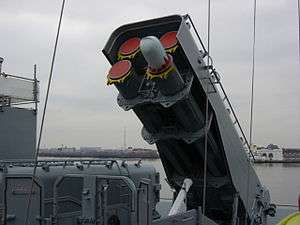
.jpg)